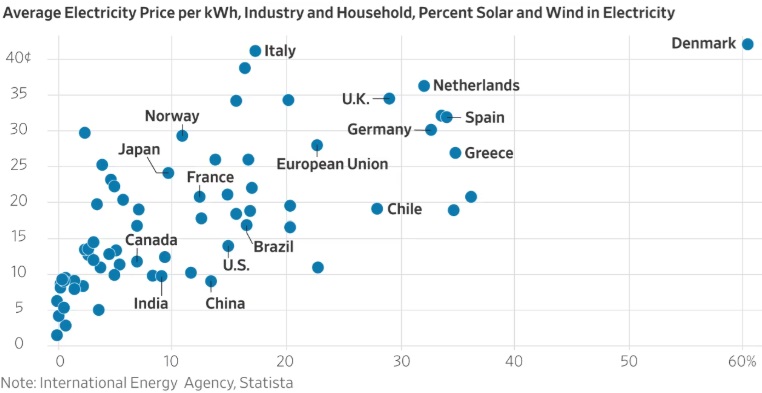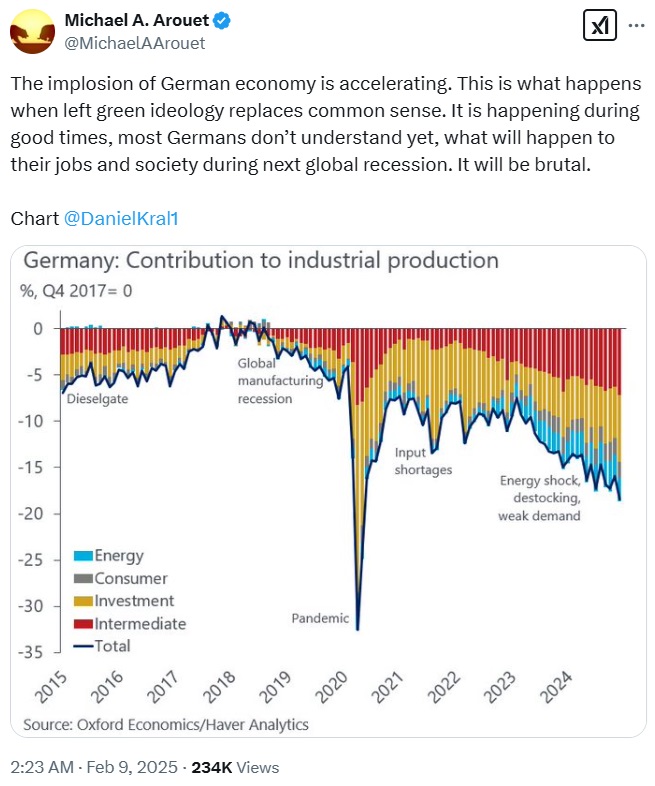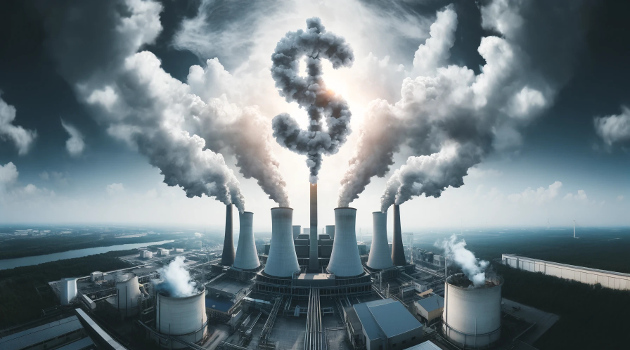The American version of the Green New Deal included some subsidies for inefficient wind and solar, but it was largely just a marketing gimmick for a big expansion in the burden of government (everything from Medicare for All to student loan bailouts).
The European version, by contrast, has been more focused on making energy more expensive by forcing consumers to use wind and solar. And, on that basis, this chart shows that it has been very effective.
But in a bad way.
Electricity prices are two to three times more expensive than they are in the United States (and about three to four times more expensive than they are in India and China).

At the risk of sounding alarmist, this is a slow-motion form of economic suicide.
The chart comes for a Wall Street Journal column by Bjorn Lomborg. Here are some excerpts.
The claim that green energy is cheaper relies on bogus math that measures the cost of electricity only when the sun is shining and the wind is blowing. Modern societies need around-the-clock power, requiring backup, often powered by fossil fuels. That means we’re paying for two power systems: renewables and backup. …The International Energy Agency’s latest data (from 2022) on solar and wind power generation costs and consumption across nearly 70 countries shows a clear correlation between more solar and wind and higher average household and industry energy prices. …At least climate-obsessed European governments are generally honest about solar and wind costs and raise electricity prices accordingly.
Some of our friends on the left applaud these outcomes as part of their campaign to discourage fossil fuels.
But what they don’t understand (or don’t care about) is that these policies make Europe very uncompetitive.
Germany is a good example of what’s happening. Though maybe I should say it’s a bad example.
Writing in National Review last November, Peter Cleppe of Brusselsreport.eu explained the consequences of “net zero” extremism. Here are a few of the relevant passages.
Ahead of the traditional October summit of EU leaders, Germany’s leading business association, BDI, launched a stern warning that deindustrialization was no longer a risk but a reality. …It is not hard to understand why German industry is struggling. …there’s the European Union’s Emission Trading Scheme (ETS), a de facto climate tax that is so high that it exceeds the full U.S. natural-gas price. …scrapping the EU’s ETS system remains an absolute taboo, despite the dire consequences this approach is having for Europe’s economic well-being. …Europeans are wary that the incoming Trump administration will start a trade war, but at the moment, it is the EU that is introducing new tariffs under the pretext of climate policy, with its new Carbon Border Adjustment Mechanism… The logic of the EU is that because the rest of the world refuses to follow its self-damaging energy policies, imports into the EU should be burdened with this new tariff.
I’ve written about the E.U.’s awful Carbon Border Adjustment Mechanism. It’s a terrible example of protectionism that almost makes Trump seem like a free trader.
To emphasize the damage of the E.U.’s “net zero” policies, I’ll close with this tweet from @MichaelAArouet.

Wow. Germany at one point was the poster child for economic success in Europe.
Now it’s backsliding and the damage is self-inflicted (and for other reasons in addition to environmental policy).
P.S. In addition to the immigration issue, I think Europe’s climate policies are driving the rise of illiberal political movements.



